

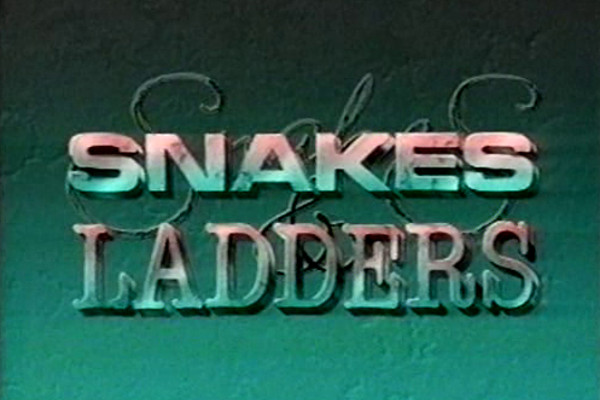
Produced by Yorkshire Television, the series ran on Channel 4 during October-November 1989. It depicted the Britain of 1999 as a totalitarian state, with patrolled borders between the north and south. Please join me in looking back at an overlooked series...
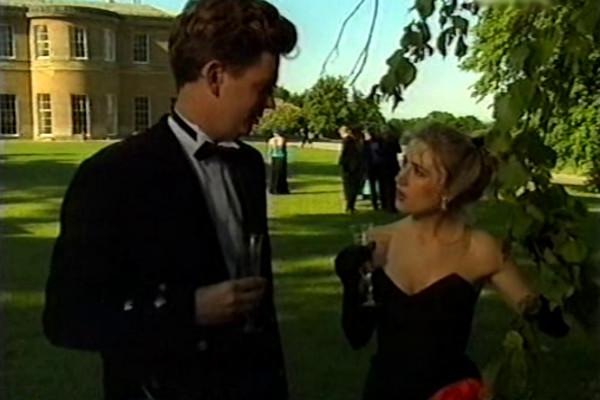
So, what was Snakes & Ladders? A satirical series set in the then-futuristic 1999, where the police are a publicly-owned company, and enforced borders divide the North and South sectors of Britain. The North is an impoverished wasteland, rife with crime, squalor and unemployment, while the South is full of riches and luxury. In a kind of futuristic Trading Places, a computer error places poor Scottish factory worker Gavin (John Gordon Sinclair) down South, with masses of credit, while rich businessman's son Giles (Adrian Edmondson) ends up placed in a manual labour job in a deprived Scotland, believing it's for work experience.
There's very little information out there regarding the show, with it not getting a mention in autobiographies, and even the Channel 4 Press Packs of the time offered little more than what would be featured in listings magazines, save for the sole piece of info that it was filmed entirely in Yorkshire. (The series was made by Yorkshire Television, and aired on Channel 4 in a Thursday night 10pm slot.)
Due to the lack of available information, I asked writers Laurence Marks and Maurice Gran about it directly on Twitter, which, if it's not bad form to quote a tweet, did at least provide some source of enlightenment as to why it seemed to end abruptly after seven episodes: "It was an odd project. Originally we wrote it as a movie. Then [Yorkshire Television] became interested because in the early days of C4, ITV [companies] made lots of shows for the new channel and Snakes had a C4 vibe. We would’ve done more but never got a re-order. Fun working with Ade and Jgs though."
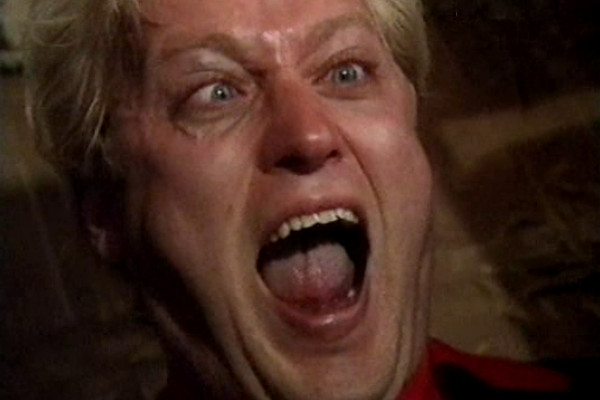
So, as a comedy, does Snakes & Ladders work? Well, not especially, but it's interesting. More "quirky" rather than something to split your sides, it was reviewed in The Independent by Stephen Pope as "a touch heavy-handed, if not downright crude". It's probably a fair assessment, and certainly more charitable than Jeremy Novick in the same newspaper, who called it "depressing" and took to listing it as a comedy in quotation marks.
Having impoverished places named after members of the Conservative government is a bit "on the nose" and obvious as satire, even if, in the 1999 in which the series was set, the much-referenced "Thatcher" had been gone for the best part of a decade. Stuff like "Murdochvision", as seen in the main image at the top of this page, doesn't really stretch much beyond surface level, though this kind of detail perhaps works better divorced from context. While at the time it may have been jarring, watched in a time where the likes of Oliver North and Keith Joseph are faded memories for many, it now provides flavour to the show, rather than being a relentless tick box of topical references.
Yet the pleasure in Snakes & Ladders comes not in expecting it to amuse, but in the intriguing world-building it offers. Adrian Edmondson spends most of the series in a world of brutalist architecture, surrounded by muggers and armed police patrols, struggling to get out but constantly failing. In a world where even the most lamentable of science fiction television manages to pick up a following, it's maybe a little surprising that this series wasn't able to do the same.
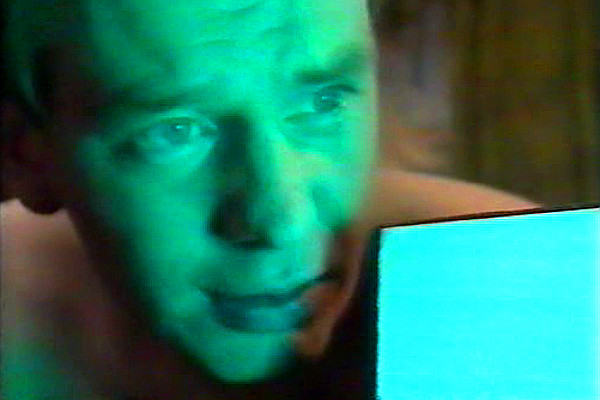
Unreleased commercially, explaining the "3rd generation off-air VHS" look of all the images captured for this article, Snakes and Ladders is a show that seems to have fallen between the cracks. Writers Laurence Marks and Maurice Gran are more famous for pretty much everything else on their C.V., with this not even being the most famous "niche early Channel 4 sitcom" they created, a honour which would go to Relative Strangers. As for the two stars, then both had projects with a higher profile. In particular, as this aired between the misfiring but notable Filthy Rich and Catflap and the engaging Bottom, it's very much a "forgotten" Edmondson project.
One major factor in the decision not to renew had to be, of course, the ratings. For whatever reason, the show never caught on, possibly due to lack of advertising, as even many Adrian Edmondson fans have never heard of it. Two of the episodes (Four and Six) fell outside the Channel 4 Top 30 altogether, whereas the remainder averaged 1.6 million viewers and 22nd place on the chart. Only one edition, the first, made the Top 20, while the highest rating was 1.83 million for the final edition, possibly inflated by the inclusion of Rik Mayall.
In contrast, quiz show Julian Clary's Sticky Moments was averaging 2.54 million viewers and 14th place on the same chart. The problem? Sticky Moments was the show that aired directly afterwards. For the five episodes that charted, then an average of 870,000 extra people were switching on their TVs as soon as Snakes and Ladders ended, an unfortunate sign for a show trying to survive. (As this is an overview article and not a factsheet, then the ratings for every individual episode won't be repeated here, but you can, should you wish, see them on the IMDb under each episode's trivia section. Don't worry, they haven't ripped me off, or vice versa - what idiot do you think is sad enough to update the entry?)
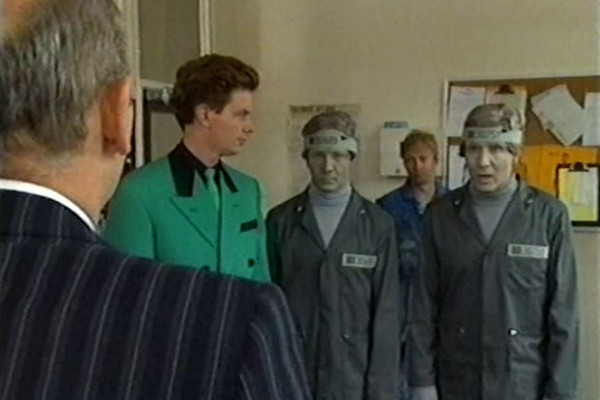
If there's one thing that marks the series out, it's very much one of tonal inconsistency. Just as the fashions and styles are very much "1980s" and not 1999, there's also a slight clash between the more offbeat style and traditional sitcom playing. Some of the characters, such as Gavin's Scottish parents, are great realisations, but there are other supporting players who seem encouraged to go a bit "broad" in a more mainstream sitcom style.
While most of the run is more "offbeat" and moderately amusing, the fifth and sixth episodes do ramp up the comedy, making it more overt. The sight of grey-faced robots conducting strike action does bring to mind the Bob Block children's comedy Roberts Robots, a series which was covered as part of the article on Rentaghost. The idea of a "worst to best" for Snakes & Ladders is really just a hook to hang an article on here, as the series is generally of a consistent standard, though episode five's broad overplaying, sped-up footage and comedy sound effects do mark it out as legitimately the least of the run.
Yet while episode six continues in the same vein, for some reason the newfound over-the-top direction the series explores in these later episodes pays off here. Possibly it's the enthused delivery of guest star Clive Rowe as "Alabama Zee Montgomery", singing the inanely catchy song "Serena", something which should be a series lowpoint, but inexplicably turns out to be a highlight. (The theme tune to the series is a rap about the ozone layer, pollution and global warming. The rapper is uncredited, but Marks and Gran confirmed that it was Clive, with lyrics by them, and music by Jim Parker.)
This is also the only episode, unusually, where the two lead characters have any serious interaction. Although Sinclair and Edmondson had briefly met and insulted each other at the border crossover in the first episode, it's only here where they get chance to interact and finally find out just what has happened to change their lives so dramatically.
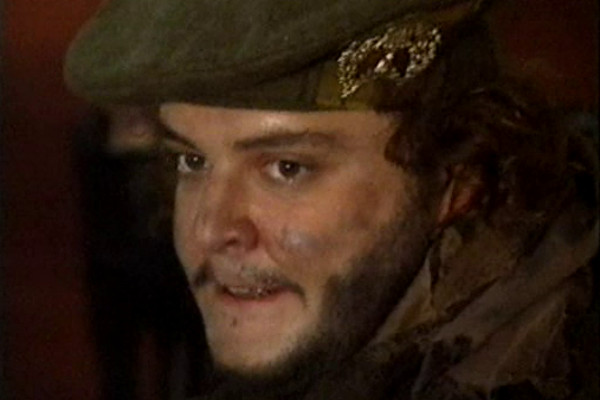
The world-building continues here, where we learn for the first time that the Labour party is extinct, and just a distant memory for a population under Thatcherite rule. It's not exactly subtle stuff, but then this is from a writing team that gave the world a political satire where the lead character's name was B'Stard, so subtlety is not necessarily in their satirical arsenal. Yet while stuff like Shine on Harvey Moon or, to an extent, Goodnight Sweetheart may be some of their better, certainly "warmer", sitcoms, this one definitely has its plusses, even if it's just hearing Frank Sidebottom singing in the background of a disco scene.
Lots of the supporting cast have associations with either previous work the writers had done, or works the stars were involved in. Particularly amusing is seeing Steven O'Donnell playing a "Scottish" thug, opposite real Scots Tony Osoba and Jake D'Arcy as interrogating policemen. Although O'Donnell had appeared in shows like The Comic Strip Presents..., he's perhaps best known as Eddie's friend Spudgun in Bottom. Sadly, what laughs there are in this black comedy often come from Osoba, O'Donnell and D'Arcy, not the two leads.
Other notable associations include Producer-Director Baz Taylor (he'd directed every single episode of Shine On Harvey Moon), John Gordon Sinclair (although a very small association, he'd had a bit part in an episode of another Marks-Gran sitcom, Roll Over Beethoven), and, of course, the final episode features Rik Mayall, who had close associations with both Edmondson and the writers.
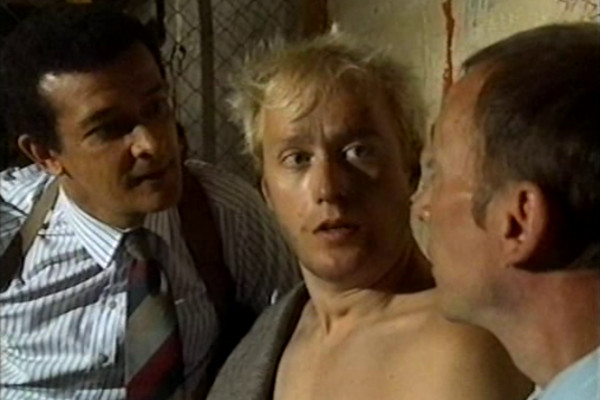
The timeline of the series is depicted via the various "Murdochvision" bulletins, and shows a surprisingly long time period: the first episode is set on May 1st 1999, while by the time of episode six we're into July. The final episode has forwarded another month to August 4th, meaning the entire programme has taken place over a three-month period.
The timeline possibly doesn't stand up to close scrutiny, given that Giles' father comes back in the last episode, and is told that they weren't expecting him for another three months... which would be a six month period, contradicting the first episode's assertion that he's going on a year-long honeymoon. (A get out is that Giles could have misunderstood his "see you next year", as six months would have pushed the date towards January 2000.)
Though probably the strangest part about all the bulletins is that they introduce "Snakes & Ladders" as a programme within the narrative of the show, even being watched by people who are starring in it. It's perhaps best not to think of this as meta, or as a Möbius strip of realities, and instead something just a bit quirky - it is, after all, a comedy series.
The whole thing may have worked better as the movie that Marks and Gran first envisioned it as, and it could still be reworked as a Film Four project, should anyone be interested in making it. If it had been shot on film, and the sillier elements toned down, it could have been a great black comedy. As it is, it still works quite well, but does seem to struggle with a real identity between the grittier politic satire and the more traditional sitcom antics.
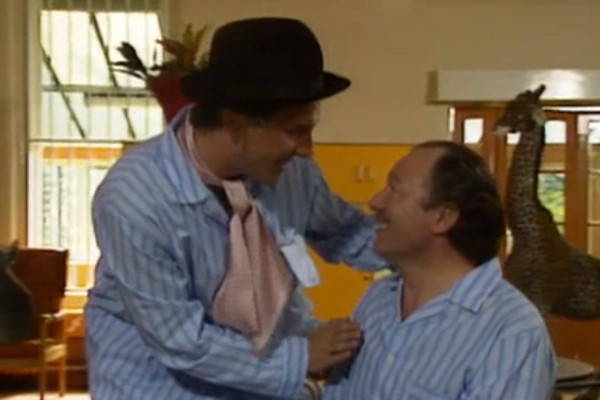
One of Snakes & Ladders' few steps outside of obscurity was as a question in a panel show hosted by David Tennant in 2012, Comedy World Cup. There, a question was asked about which sitcoms were real and which were made up, a round which also featured Tennant's own Duck Patrol. A clip was shown, which received a fair amount of laughs from the studio audience. Unfortunately the two people getting the laughs weren't the stars, but Rik Mayall and Ken Livingstone.
The aforementioned Jeremy Novick slated this one in The Independent as "Political satire, or what? Sadly, the answer is or what". Yet the sight of Ken Livingstone sending himself up as "Red Ken", getting aroused over the word "strike" and having to be placated by Rik Mayall giving him a copy of "Marxism Yesterday" to settle him down may be the series' highest peak.
However, the reviews weren't all bad. James Green in The Stage praised the show, while acknowledging some bits worked better than others, declaring that it "deserves to enjoy more than a cult following". Generally, though, the reviews were mixed, with Jim Kelly in the Aberdeen Evening Express suggesting it "had its moments".
Despite this, the series has aged surprisingly well, but unless it gets another shot on streaming services (you can always politely tweet Britbox and ask them if they'd give it a chance) it remains destined to be a largely-forgotten curio.